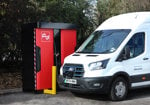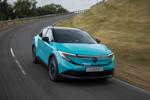Fleets and car manufacturers are at the vanguard of reducing emissions in the UK, together helping to introduce more and more new cars with an ever lower impact on the environment.
As a result, the average new car in the UK now emits 158g/km of CO2, down from an average of nearly 165g/km last year, and a drop of 32g/km since the base line for figures was introduced in 1997 by the Society of Motor Manufacturers and Traders (SMMT).
Much of this performance comes down to the way company vehicles are treated in terms of Government legislation, particularly in terms of benefit-in-kind taxation being linked to CO2 emissions.
Fleet managers are now well-versed in the two key thresholds for emissions – 120g/km and below spells big savings for drivers’ company car tax bills, while 160g/km and under has huge implications in terms of writing down allowances (the amount of a vehicle’s depreciation that can be off-set against tax).
The push for company car drivers to lower their tax bills has seen the number of sub-120g/km vehicles sold in the UK rise markedly – in 2008, they accounted for nearly 11% of the new car market, compared to 5.4% in 2007 and just 0.1% in 2000.
And as the April tax deadline looms for vehicles emitting 160g/km or less, expect more registrations of vehicles falling into this category.
But although the 158g/km vehicle average is heading in the right direction, there is still some way to go to meet the European Union new car CO2 average emissions target of 130g/km by 2015.
Some manufacturers are nearing that target, with volume-weighted average CO2 analysis by Jato showing that Fiat’s average vehicle emissions were 133.7g/km last year.
Peugeot is close behind with an average of 138.1g/km.
#FNN_ART_SPILT#
Fiat's emission strategy
The Italian manufacturer’s low-emission performance is a result of a focus on engine technology and a bias in sales towards smaller vehicles.
Low-emission MultiJet diesels appear across the range and a stop-start system, which cuts the engine when the car is idling, is fitted to the 500 and will soon be rolled out across other models.
Later this year, Fiat will introduce MultiAir, a new petrol engine technology which is claimed to increase power by 10% and reduce CO2 emissions by between 10 and 25%.
The Mito, from sister company Alfa Romeo, will be the first model to feature this technology later this year.
Also helping to improve economy and lower emissions is eco:Drive, a software developed with Microsoft which uses a USB stick to record driver inputs and then analyses the data to suggest how to modify their behaviour to boost economy.
PSA's electric future
French conglomerate PSA, which encompasses Citroën and Peugeot, currently enjoys low average CO2 performance thanks to its range of small cars and its extensive HDi turbodiesel engine technology, but electric vehicles and diesel hybrids are on the cards.
By 2011 both brands will offer diesel electric hybrids with the ability to return 68mpg and CO2 of 109g/km in a 200bhp family saloon.
Citroën already offers start-stop technology on its C2 and C3 models, and this technology will be advanced with a micro-hybrid system which will also collect regenerative power from braking.
PSA aims to have this fitted to the C3 Picasso by next year.
PSA is, like Toyota, working with EDF in the development of electric and plug-in hybrid models.
Toyota's hybrid route
Toyota has been blazing the trail for hybrid models since the launch of the Prius back in 2000, bringing the wizardy (at the time) of a car powered by both a petrol engine and an electric motor.
With other volume manufacturers still playing catch-up on hybrids, Toyota is taking things to another level – the new version on sale in July will return 72.4mpg and emit just 89g/km of CO2 (the current version offers 104g/km and 65.7mpg economy).
This in turn will be joined by a plug-in version, although not for a couple of years.
Toyota is currently trialling a plug-in Prius with energy company EDF in Strasbourg.
















Login to comment
Comments
No comments have been made yet.